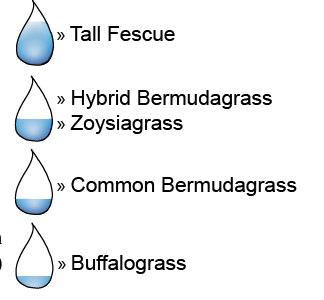Lawn Watering Tips
Lawn Watering Tips
Turfgrass plays an important role in urban landscapes. It reduces effects of water and wind erosion, provides a space for recreation, and increases property value. However, it can be difficult to know how much and when to water. Therefore, it is imperative to learn how to properly take care of our lawns while responsibly using water resources. Listed below are a few tips to help homeowners properly water the landscape.
To Water or Not to Water?
- Water according to the weather. Use less water when cooler temperatures, overcast skies, high humidity, or rain are present.
- Use a screwdriver to check soil moisture before watering, if it goes in easily don’t water.
- Do not water when temperatures are below 40°F, which can cause hazardous conditions such as ice formation on plants, driveways, and sidewalks.
- Water your lawn before 10 AM. This will reduce evaporative water loss and decreases risk of disease from allowing water to sit on leaves overnight.
- Check your local weather forecast. You may not need to water if there is a high chance of rain!
- Do not water during high wind, which causes needless water loss by moving water away from the lawn and onto hardscapes.
Grow Your Best Lawn
- Select warm-season grasses that require less water like bermudagrass, zoysiagrass, and buffalograss.
- Do not mow your lawn too short. Grass acts as a natural mulch, retaining soil moisture and shading out weeds. As a rule of thumb, mow bermudagrass and zoysiagrass at 2-3 inches and buffalograss and tall fescue at 3-4 inches.
- Leave grass clippings on lawn.
- Know your soil type. Sandy soils need lighter, more frequent watering but clayey soils need heavier, less frequent watering. Applying water faster than it can soak into the soil will cause water (and your money) to run off the lawn!
- Aerate your lawn regularly. This improves water movement through the soil and aides in root development.
- Use mulch, such as compost or wood chips, to reduce evaporative water loss from the soil surface. Using mulch also reduces the growth of weeds and prevents soil compaction.
- Control weeds to reduce competition for water and nutrients.
- To conserve water, do not over-seed warm-season lawns with cool-season grasses. Over-seeded lawns require more irrigation than dormant grass.
Always Remember
- Collect and use rainwater when possible.
- Do not water hardscapes.
- Check your sprinkler heads. You may need to adjust, repair, or replace them.
- Overwatering is not only wasteful but harmful to turf, increasing the risk of disease and thatch buildup.
Relative Water Requirements
Rain barrels can be used to conserve water
The City of OKLAHOMA CITY UTILITIES DEPARTMENT
Oklahoma Cooperative Extension Service
Division of Agricultural Sciences and Natural Resources
Oklahoma State University



